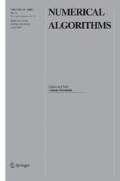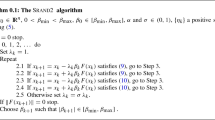Abstract
The famous for its simplicity and clarity Newton–Kantorovich hypothesis of Newton’s method has been used for a long time as the sufficient convergence condition for solving nonlinear equations. Recently, in the elegant study by Hu et al. (J Comput Appl Math 219:110–122, 2008), a Kantorovich-type convergence analysis for the Gauss–Newton method (GNM) was given improving earlier results by Häubler (Numer Math 48:119–125, 1986), and extending some results by Argyros (Adv Nonlinear Var Inequal 8:93–99, 2005, 2007) to hold for systems of equations with constant rank derivatives. In this study, we use our new idea of recurrent functions to extend the applicability of (GNM) by replacing existing conditions by weaker ones. Finally, we provide numerical examples to solve equations in cases not covered before (Häubler, Numer Math 48:119–125, 1986; Hu et al., J Comput Appl Math 219:110–122, 2008; Kontorovich and Akilov 2004).
Similar content being viewed by others
References
Argyros, I.K.: On the Newton–Kantorovich hypothesis for solving equations. J. Comput. Appl. Math. 169, 315–332 (2004)
Argyros, I.K.: A unifying local–semilocal convergence analysis and applications for two-point Newton-like methods in Banach space. J. Math. Anal. Appl. 298, 374–397 (2004)
Argyros, I.K.: On the semilocal convergence of the Gauss–Newton method. Adv. Nonlinear Var. Inequal. 8, 93–99 (2005)
Argyros, I.K.: Computational theory of iterative methods. In: Chui, C.K., Wuytack, L. (eds.) Studies in Computational Mathematics, vol. 15. Elsevier, New York (2007)
Argyros, I.K.: On a class of Newton-like methods for solving nonlinear equations. J. Comput. Appl. Math. 228, 115–122 (2009)
Argyros, I.K., Hilout, S.: Efficient Methods for Solving Equations and Variational Inequalities. Polimetrica Publisher, Milan (2009)
Argyros, I.K., Hilout, S.: Enclosing roots of polynomial equations and their applications to iterative processes. Surv. Math. Appl. 4, 119–132 (2009)
Blum, L., Cucker, F., Shub, M., Smale, S.: Complexity and Real Computation. With a Foreword by Richard M. Karp.. Springer, New York (1998)
Ben-Israel, A.: A Newton–Raphson method for the solution of systems of equations. J. Math. Anal. Appl. 15, 243–252 (1966)
Ben-Israel, A., Greville, T.N.E.: Generalized Inverses. Theory and Applications, 2nd edn. CMS Books in Mathematics/Ouvrages de Mathématiques de la SMC, vol. 15. Springer, New York (2003)
Dedieu, J.P., Kim, M.-H.: Newton’s method for analytic systems of equations with constant rank derivatives. J. Complex. 18, 187–209 (2002)
Dedieu, J.P., Shub, M.: Newton’s method for overdetermined systems of equations. Math. Comput. 69, 1099–1115 (2000)
Ezquerro, J.A., Hernández, M.A.: Generalized differentiability conditions for Newton’s method. IMA J. Numer. Anal. 22, 187–205 (2002)
Ezquerro, J.A., Hernández, M.A.: On an application of Newton’s method to nonlinear operators with w-conditioned second derivative. BIT 42, 519–530 (2002)
Gutiérrez, J.M.: A new semilocal convergence theorem for Newton’s method. J. Comput. Appl. Math. 79, 131–145 (1997)
Gutiérrez, J.M., Hernández, M.A.: Newton’s method under weak Kantorovich conditions. IMA J. Numer. Anal. 20, 521–532 (2000)
Häubler, W.M.: A Kantorovich-type convergence analysis for the Gauss–Newton-method. Numer. Math. 48, 119–125 (1986)
Hernández, M.A.: The Newton method for operators with Hölder continuous first derivative. J. Optim. Theory Appl. 109, 631–648 (2001)
Hu, N., Shen, W., Li, C.: Kantorovich’s type theorems for systems of equations with constant rank derivatives. J. Comput. Appl. Math. 219, 110–122 (2008)
Kantorovich, L.V., Akilov, G.P.: Functional Analysis. Pergamon, Oxford (1982)
Li, C., Zhang, W.-H., Jin, X.-Q.: Convergence and uniqueness properties of Gauss–Newton’s method. Comput. Math. Appl. 47, 1057–1067 (2004)
Li, C., Hu, N., Wang, J.: Convergence bahavior of Gauss–Newton’s method and extensions to the Smale point estimate theory. J. Complex. 26, 268–295 (2010)
Potra, F.A.: On the convergence of a class of Newton-like methods. In: Iterative Solution of Nonlinear Systems of Equations (Oberwolfach, 1982). Lecture Notes in Math., vol. 953, pp. 125–137. Springer, New York (1982)
Potra, F.A.: On an iterative algorithm of order 1.839 ⋯ for solving nonlinear operator equations. Numer. Funct. Anal. Optim. 7(1), 75–106 (1984/85)
Potra, F.A.: Sharp error bounds for a class of Newton-like methods. Libertas Mathematica 5, 71–84 (1985)
Shub, M., Smale, S.: Complexity of Bezout’s theorem. IV. Probability of success, extensions. SIAM J. Numer. Anal. 33, 128–148 (1996)
Smale, S.: The fundamental theorem of algebra and complexity theory. Bull. Am. Math. Soc. 4, 1–36 (1981)
Smale, S.: Newton’s method estimates from data at one point. In: The Merging of Disciplines: New Directions in Pure, Applied, and Computational Mathematics (Laramie, Wyo., 1985), pp. 185–196. Springer, New York (1986)
Smale, S.: Complexity theory and numerical analysis. In: Acta Numerica, pp. 523–551. Cambridge University Press, Cambridge (1997)
Traub, J.F., Woźniakowski, H.: Convergence and complexity of Newton iteration for operator equations. J. Assoc. Comput. Mach. 26, 250–258 (1979)
Wedin, P.A.: Perturbation theory for pseudo-inverse. BIT 13, 217–232 (2000)
Xu, X., Li, C.: Convergence of Newton’s method for systems of equations with constant rank derivatives, J. Comput. Math. 25, 705–718 (2007)
Xu, X., Li, C.: Convergence criterion of Newton’s method for singular systems with constant rank derivatives. J. Math. Anal. Appl. 345, 689–701 (2008)
Author information
Authors and Affiliations
Corresponding author
Rights and permissions
About this article
Cite this article
Argyros, I.K., Hilout, S. On the solution of systems of equations with constant rank derivatives. Numer Algor 57, 235–253 (2011). https://doi.org/10.1007/s11075-010-9426-5
Received:
Accepted:
Published:
Issue Date:
DOI: https://doi.org/10.1007/s11075-010-9426-5




